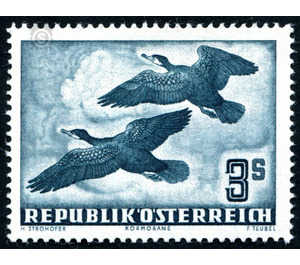birds - Austria / II. Republic of Austria 1953 - 3 Shilling
Theme: Animals
| Country | Austria / II. Republic of Austria |
| Issue Date | 1953 |
| Face Value | 3.00 |
| Edition Issued | 350,000 |
| Color | green |
| Printing Type | Typography |
| Stamp Type | Air Post |
| Item Type | Stamp |
| Chronological Issue Number | 328 |
| Chronological Chapter | OOS-OE2 |
| SID | 872014 |
| In 28 Wishlists | |
2. Air mail series "Vogelflug" - Cormorants There was no need for an air mail series, but the post office wanted to follow the tradition of the prewar period, when a series of airline stamps had appeared simultaneously (eg 1925 and 1935). The designer Prof. Hans Strohofer consciously dispensed with the then customary framing of the brand image in his designs to indicate the vastness and "boundlessness" of the sky. 29.9.1953: 4th value 3S: Cormorants Once there were large breeding colonies in the Danube floodplains. Due to strong human persecution, the cormorant stocks in Central Europe fell rapidly, in Austria, he was even eradicated. Since the early 1990s, he has been breeding regularly in the March-Thaya-Auen. The cormorant populations in Central Europe have recovered, therefore the cormorant is also regularly found in the waters of Vienna during the wintertime, e.g. the water park and the Danube Canal. The colder it gets, the more waters freeze, and the fish-eater cormorant has to move to ice-free places. With a little luck, he can even be observed fishing in the middle of Vienna, for example in the city park. The Cormorant is an underwater hunter. Unlike the ducks and most other underwater hunters, the cormorant's feathers absorb water. In order for the plumage to dry faster, the cormorants sit with their wings spread wide after the dives. 6 April 1956: The end of the airmail stamps: With instructions from the General Postdirektion, all airmail stamps were declared postage stamps and released at franking for all postal items. The fact that Austrian Airmail stamps were in the past only permitted for the franking of air mail items had occasionally given rise to errors. Balloon mail was NOT considered an airmail: When the first balloon mail was granted to the Austrian Children's Village Association in 1948, Austria was not allowed by the allied victorious powers to operate an airmail in its independent sphere of influence. However, in order to be able to set up the balloon post at all, the PT established that this mailing was not an airmail, because the authorization of the Allied occupying powers would have had to be obtained for this purpose. The balloon mail was therefore declared to interest post offices, whereby it was left to the organizers, with which means of transport the mail was carried. A parallel case to these balloon items was the Segelflugpost 1950 from Graz on the occasion of the jubilee exhibition "100 Years Stamp". Consequently, the use of airmail stamps for these mailing operations was also inadmissible, except in the case of airmail being forwarded. The airmail surcharge was credited to the country, whose aircraft then transported the post. The only exception was the 4th balloon mail on 21.10.1950, which was also the first day of the first two airmail stamps of this series (60 g and 2.-S), as by an "erroneous interpretation" of the then new provisions also for the domestic addressed balloon mail items airmail stamps were accepted for franking. This was immediately banned by a separate disposition for all subsequent events.


